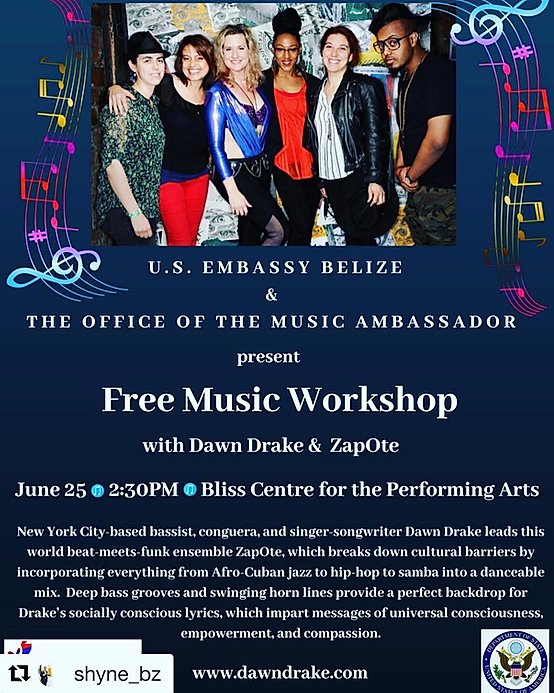
If she’s not the busiest musician in NY, surely there’s none busier than Dawn Drake.
The funky bassist-percussionist, vocalist and composer, averages up to three gigs a week (and as many as eight) in various settings--bandleader, backing musician, solo player and dance class accompanist for top companies like Alvin Ailey and Mark Morris.
An Afro-Cuban/Brazilian percussionist (specializing in congas but deft on a panoply), she also teaches courses in Caribbean music at John Jay College, and has extensively promoted gender equality and women’s empowerment through music with such organizations as New York City Public School System, Brooklyn Arts Council, and even the U.S. Embassy for a project to benefit Belize.
And if all this isn’t enough, she has a new album, Nightshade, just released, with her band ZapOte—named for the tasty Caribbean fruit that grows throughout the Caribbean and Mexico. It’s also the title of a song on her preceding album Everythinglessness, the chorus of which was written years earlier after a visit to Santiago de Cuba--a place that has greatly inspired her through its music, dance and culture, not to mention the country where she first encountered the fruit.
The album, however, is named for a family of plants—some edible, some toxic—with the title also connoting a darker side of ZapOte.
“We play a lot of party gigs and it’s a party band,” says Virginia native Drake, whose nine-piece percussion- and horn-heavy group delivers what she calls “a globe of musical language” in her compositions, these reflecting her intensive studies of African and Caribbean music genres as well as socially-conscious lyrics geared toward promoting multiculturalism, tolerance and understanding.
But Nightshade, she notes, differs from ZapOte’s other albums: Rather than party songs, the 10 tracks (plus previously-released bonus track “Wake Up,” concerning environmentalism) are indeed “darker in mood” while hewing to a sound she characterizes as “chronic grooves from the Global South,” i.e., “the American South and the Caribbean and Latin America—though it could also include India and Africa. I’m bridging all the traditions together.”
The “chronic” in “chronic grooves,” she adds, can reference the presence of both reggae and hip-hop elements in her eclectic output.
Nightshade is further distinguished by its greater emphasis on instrumentals, fusing Cuban and Indian attributes, as in “Puriya Makuta”—an original interpretation of a North Indian evening raga melody arranged by Grammy-nominated sarod player Aashish Khan, son of the late sarod virtuoso Ali Akbar Khan; Drake had studied with Aashish at California Institute of the Arts in Santa Clarita in 2012, and sees Nightshade as the result of composing there for larger ensembles.
“I wanted to get out of the whole ‘singer-songwriter’ process of my earlier records and more into instrumental composition—though there are still some songs on Nightshade,” she says. Among them, “Salon du coiffure” deals with misinterpretation of text messages, while “Zim Ta Tim” is a stream-of-consciousness piece.
The lead track/first single “Oya de Zarija” tenders an electronic take on an invocation to Oya, a fierce female warrior deity of many things (including violent storms, life and death) in the religion of the Yoruba people of western Africa, whose traditions were brought to the Americas via the slave trade. The dead being one of Oya’s interests, “remembering our ancestors” is also a key theme of Nightshade, says Drake, for whom Oya offers a positive role model.
“She’s always been one of my powerful icons that I look to as a female figure/deity that I can see myself in--and everything I do in being an artist.”
Regarding the album’s production, Drake sought “a retro sound reminiscent of the 1970s that could tie all the compositions together.” She credits recording engineer Dan Grigsby (recording/production credits include Paula Abdul and Grover Washington) and mixing engineer Jeremy Page (Ghostface Killah, Kendra Morris) for helping sculpt it.
“One of my goals was to combine two passions of mine--music and positive social change,” says Drake, who remembers hearing music by Johnny Cash alongside The Gap Band growing up in the mountains of Virginia—and being a punk rocker in high school.
“I also played classical piano, and then jazz in high school, but without any context,” she adds. “I had no idea what I was doing—but I was doing it.”
And she was a dance enthusiast “in love with Michael Jackson,” and wanted to be a fly girl dancer.
“I got into drumming through dance,” recalls Drake, who left Virginia at 18 to begin her unique musical odyssey.
“I went to school at University of California, Berkeley, then studied abroad in Ghana in 1992 and `93, and started playing there, then went back to Berkeley and finished there in `94. I traveled around Guatemala, Mexico and Belize for a couple of months--all with very little money, having worked at the same salad restaurant on Telegraph Avenue in Berkeley for over five years--and then moved back to Virginia, working at Domino’s Pizza and the Cannonball Restaurant for two months before boarding a Greyhound and moving to New York in `95 around Halloween.”
Inspired by her trip to Ghana, Drake began taking West African dance classes at Fareta Dance School, where she met conga teacher Juma Santos, who had worked with Nina Simone, among others. He suggested that she learn the double-headed Yoruba batá drum--which was originally used for religious purposes--and go to Cuba, where the batá was brought over by slaves.
“He [Juma Santos] connected the dots from ethnic groups from West Africa to Haiti and Cuba, with an African-American perspective,” says Drake. “I saw all the different connections between the tribes and groups that came and planted themselves in the different islands, and was fascinated and did a lot of reading.”
Also after moving to New York, Drake began playing bass.
Dawn Drake's remixed "Wake Up"
“I went to a guitar store on St. Mark’s Place and a bass jumped off the wall and landed in my lap!” she jokes. “I had had no intention of being a bass player, but started playing around, and a year later Herbie Mann’s son Geoff [who remixed ‘Wake Up’ on Nightshade] and all these cats from The New School for Jazz and Contemporary Music were playing Grateful Dead covers and putting together a jam band. They didn’t want a jazz bass player but one that was rock simple, so they chose me and I just started playing.”
But she was also playing congas now, and took up Santos’s suggestion to take up the batá when the female guitarist in the jam band, who was into samba, was also learning percussion and playing batá. “Women traditionally weren’t allowed to play the batá, and you need three batá players in Afro-Cuban Santeria [religious] music, so I learned,” says Drake.
Santos, meanwhile, had also encouraged her to study ethnomusicology.
“So I saved up my money working at the Peculier Pub on Bleecker Street and went to Cuba on a group trip with an organization called Caribbean Music and Dance. We studied Haitiano-Cubano folkloric music and dance in Guantanamo for two weeks, then I stayed in Santiago by myself for another two weeks and continued to study.”
While still with the group she met Ben Lapidus, now head of John Jay’s music department, who was then entering the PhD program in ethnomusicology at CUNY (City University of New York) Graduate Center.
“When I got back, I applied to the program, interviewed with [noted ethnomusicologists] Peter Manuel and Stephen Blum and got in. I started studying with Peter Manuel in 1998 at CUNY Graduate Center.”
Manuel, incidentally, authored Caribbean Currents: Caribbean Music from Rumba to Reggae, which Drake uses in her John Jay course. But she never did finish her own PhD studies.
“I don’t want to write papers talking about music. I want to play music!” she says. “So I quit in order to play, and in the meantime I did every job in the book: bartender at a Jamaican restaurant, working for a local Jamaican music label, bartending for parties.”
She also started writing her own music—after taking voice lessons with Judy Hages.
“I met her through Bridget Barkan, a great singer who toured with the Scissor Sisters,” says Drake. “We were in a band together with Kat Rodriguez—who’s in Beyonce’s band. Judy coached Q-Tip—I actually went to class regularly with him—and is responsible for me making my first recordings: She handed me $500 and said, ‘Here. Get one of your songs produced and recorded.’ That started me on my journey towards recording my original music, using all the rhythms I’d learned through my studies. That’s what artists do—make a big stew out of everything that’s inspired them!”
Drake was greatly inspired, too, by Julia Cameron’s best-selling The Artist’s Way, “kind of like a guidebook for living an artistic life. It’s a long road, but sometimes things just happen.”
Her own artistic road climaxed when she started her own band, which for a decade was quite successful on the international private party circuit. She began teaching at John Jay when Lapidus offered her a position there three years ago.
“The history of Caribbean music and the African diaspora is really important for everyone to know, because it’s the roots of American music,” says Drake. “Culturally speaking, American music is creole, syncretized music, but for marketing purposes it’s been split up and racialized.”
Likewise, Drake’s music is “genre-defying,” as is the broad-based New York music scene she’s a big part of.
“It draws from [African and Latin American music genres] soukous, chicha, cumbia, kompa, Afro-Cuban and Afrobeat to name a few, with artists like MAKU Soundsystem, Fulaso, Spanglish Fly, Esso Afrobeat, Kaleta and the Super Yamba Band, Mariella Price and [Brooklyn dance club] Bembe’s ‘Rhythm Section Sundays’ DJs Mickey Perez and modrums, and the Zona Libre tropical dance music party--and so many others,” says Drake, who in addition to her own band, plays with numerous world music artists including Fulaso, Stefan Zeniuk's Green Mambo, Haitian singer Darline Desca, Brooklyn bhangra band Red Baraat’s Sonny Singh, Ivory Coast artists Azouhouni Adou and Pablo Djembe, singer-songwriter Lee Taylor and Alvin Ailey Dance Theater’s Noibis Licea.
“It’s an eclectic New York music scene,” she says, placing herself firmly within several subdivisions: Latin funk, Afrobeat, Afro-Cuban, African, Brazilian, Caribbean. “That’s why I live in New York—so I have access to all the different scenes.”
And she’s particularly proud to be creating space for women in music in New York.
“It’s not hard to get females who know how to play,” she says. “But it’s a challenge to find work as a female side person playing my instruments.”
Drake concludes, “If a door closes on you, you make your own path--which I feel I’ve done: Doors closed on me many times, and I could either sit at home and do nothing or make something happen—and that’s what I’ve done.”
Recent Posts
Archive
Tags
Related posts








